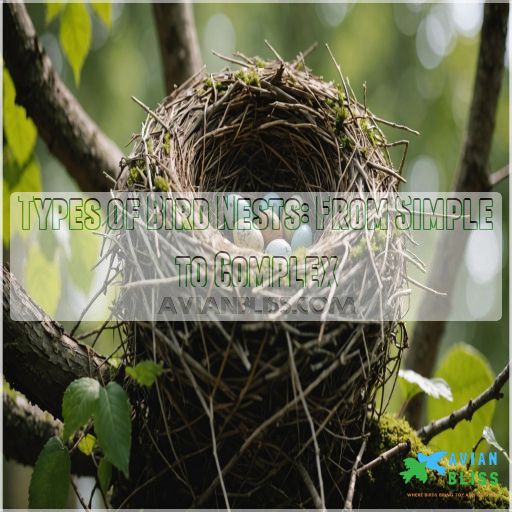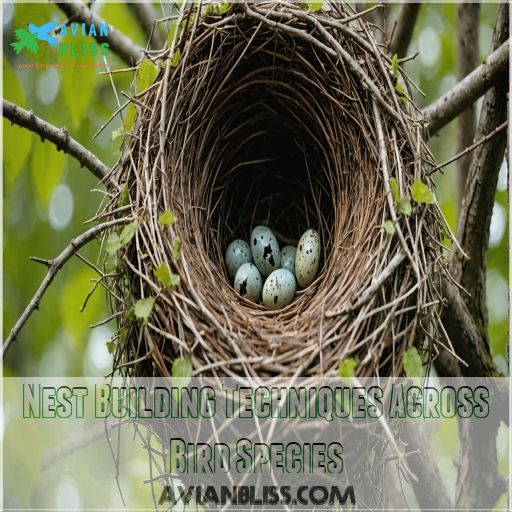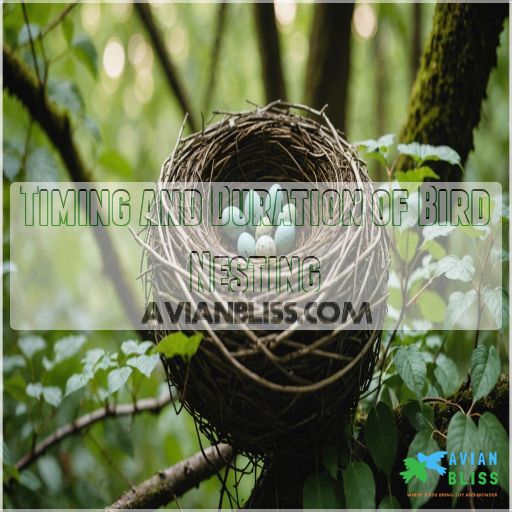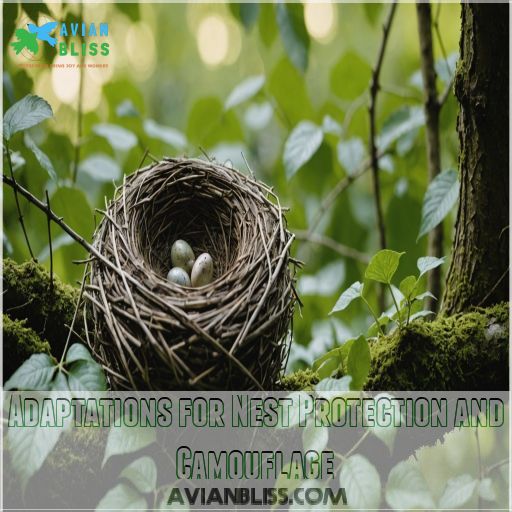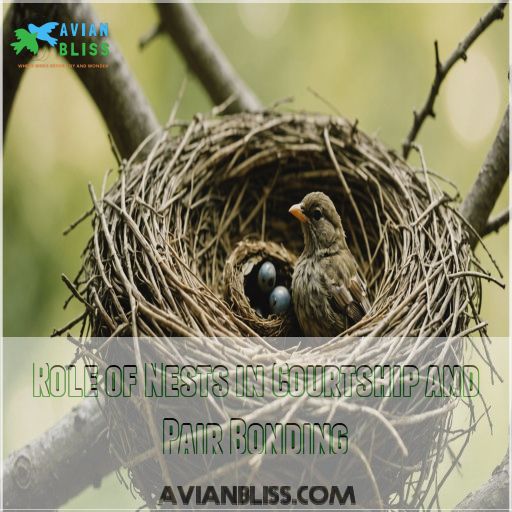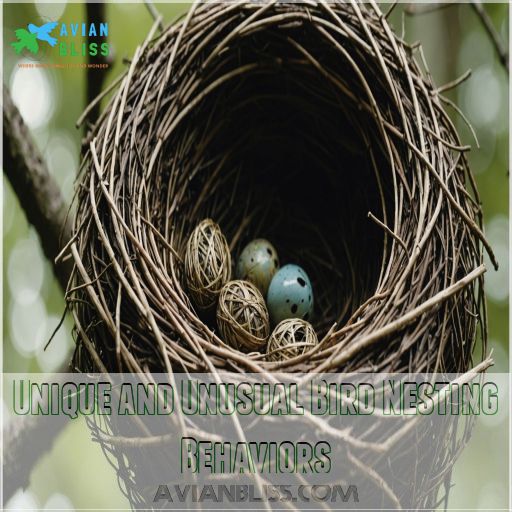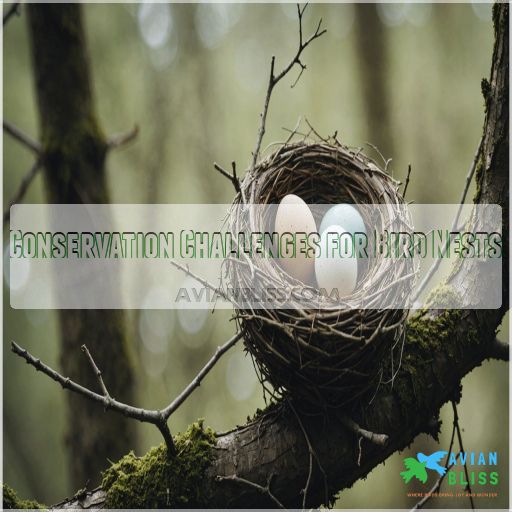This site is supported by our readers. We may earn a commission, at no cost to you, if you purchase through links.
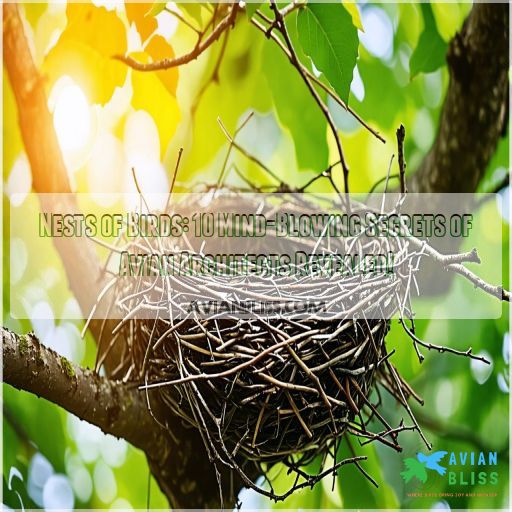
Some birds dig burrows like real estate developers underground, while others use mud like expert architects. Materials range from twigs and grass to human-made bits like string and plastic, showing off their urban adaptability.
These nests offer safety and a cozy home to their occupants. Ever wondered why some birds choose cliffside views for their homes? Stick around for more secrets of avian architecture that’ll keep you intrigued!
Table Of Contents
- Key Takeaways
- Types of Bird Nests: From Simple to Complex
- Materials Used in Bird Nest Construction
- Nest Building Techniques Across Bird Species
- Nest Locations: From Ground to Treetops
- Timing and Duration of Bird Nesting
- Adaptations for Nest Protection and Camouflage
- Role of Nests in Courtship and Pair Bonding
- Environmental Factors Influencing Nest Design
- Unique and Unusual Bird Nesting Behaviors
- Conservation Challenges for Bird Nests
- Frequently Asked Questions (FAQs)
- How do I know what kind of bird nest I have?
- What does it mean when birds make nests around your house?
- What are the five different birds nests?
- How long will a mother bird leave her nest?
- How do birds choose nesting materials?
- What are common predators of bird nests?
- How do urban environments affect nesting?
- How do birds maintain nest hygiene?
- How often do birds reuse nests?
- Conclusion
Key Takeaways
- You’ll be surprised by what birds use to build their nests; from twigs and grass to string and plastic, these tiny architects show off their creativity and adaptability in both urban and natural settings. Imagine them gathering materials as if they’re on a scavenger hunt across the neighborhood!
- Birds have mastered the art of choosing the perfect real estate, strategically placing nests in trees, cliffs, buildings, and even on water. It’s as if they’ve discovered secret spots humans haven’t even thought about yet.
- Nest-building isn’t just a home improvement project; it’s also an important part of courtship. Male birds often wear their best builder hats to impress potential mates – kind of like sprucing up a bachelor pad before company comes over.
- Climate change, predators, and human disturbances challenge birds’ nesting efforts, forcing them to continually adapt. Birds continually adapt to these challenges, keeping one eye out for today’s wild curveballs.
Types of Bird Nests: From Simple to Complex
You’re about to explore the incredible variety of bird nests, from simple ground scrapes to intricate suspended homes.
These avian architects use an array of materials and techniques to create safe havens for their eggs and chicks, adapting to different environments with ingenuity that rivals human builders, showcasing their ingenuity.
Cup-shaped Nests
While you’re out bird-watching, you might spot a cozy little bowl nestled in a tree fork – that’s a cup-shaped nest. These avian apartments are nature’s cradleboards, built by skilled feathered architects like robins and vireos.
They’re woven from grasses, twigs, and sometimes mud, then lined with soft materials like feathers or fluffy seeds.
It’s like they’re creating the perfect tiny mattress for their eggs, making them a tiny mattress.
Scrape Nests
You’ve seen cup-shaped nests, but let’s talk about the minimalists of the bird world: scrape nesters. These feathered architects keep it simple, creating shallow depressions in the ground. It’s like they’re playing a game of "how low can you go" with nest building!
They often choose high and hidden spots for nesting, and their roof overhangs, eaves, and chimney openings can be attractive nesting sites for birds.
Understanding the reasons behind birds nesting around homes can help us appreciate the importance of safe bird nest removal.
- Perfect camouflage for eggs
- Built by rocking bodies or feet
- Often found on beaches or loose soil
- Home to quick-escaping chicks
Burrow Nests
Burrow nests take bird architecture to a whole new level – literally! These underground havens offer feathered families excellent protection from predators and harsh weather. You’ll find these cozy dugouts in various locations, from riverbanks to termite mounds.
Let’s dig into some fascinating burrow nesters:
| Bird Species | Burrow Characteristics |
|---|---|
| Kingfishers | Hefty beaks for digging |
| Burrowing Owls | Often repurpose prairie dog holes |
| Bank Swallows | Tunnel up to 5 feet long |
Who knew birds could be such talented subterranean engineers? It’s like they’ve got their own little avian speakeasies hidden away!
Mound Nests
Imagine a clever architect designing a cozy home just for eggs.
Mound nests do just that, evolving through time to cleverly use mud, branches, and leaves. Male birds masterfully build these incubating wonders in secure nesting colonies, offering predator defense.
Meanwhile, human impact is a wild card, affecting these fascinating nests in unpredictable ways.
Cavity Nests
Peering into the realm of cavity nests, you’ll find birds using clever adaptations to thrive in these snug homes.
Competition can be fierce, as these nests are prime real estate. Woodpeckers carve cozy cribs, while owls gladly settle into vacated spaces.
Conservation plays a role, ensuring dead trees remain for these avian architects. Nature’s housing market never rests, as it is crucial for the survival of these birds in their snug homes.
Platform Nests
Building a platform nest is like crafting a sturdy penthouse for birds, where species like ospreys and eagles demonstrate avian architecture brilliance.
They utilize:
- Materials: Twigs, leaves, even bones.
- Location: Trees, cliffs, or artificial platforms.
- Evolution: Adaptations for size and predator deterrence.
These grand nests offer safety and reuse advantages, evolving over countless generations.
Pendant Nests
You can’t help but admire the pendant nest’s evolution, hanging like a nature-made ornament.
Woven by species such as Baltimore orioles, these elaborate sacks use grass, hair, and bark.
Nest location high in trees keeps them safe from predators.
Yet, challenges like wind and rain test their durability.
Orioles, resilient architects, adapt beautifully through it all.
Materials Used in Bird Nest Construction
You’ll be amazed by the diverse materials birds use to construct their nests.
From natural twigs and leaves to human-made items like string and plastic, these feathered architects show incredible creativity and resourcefulness.
Natural Materials (Twigs, Grass, Leaves)
Imagine a bird crafting its home using twigs, grass, and leaves—a true masterpiece of nest building.
Birds rely on what nature provides, even as materials change with seasons.
Consider these elements:
- Twigs: For structural strength.
- Grass: Adds comfort and insulation.
- Leaves: Offer camouflage.
- Spider silk: Nature’s glue.
These choices reflect remarkable evolutionary adaptations!
Mud and Clay
Twigs and leaves might seem straightforward, but mud and clay bring a crafty twist to nest building. These soggy sheriffs keep things stable, sticking like glue to walls and cliffs. It’s a messy job, but hey, somebody’s gotta do it!
Check out this table of curious creators:
| Bird Type | Mud Nest Location | Mud Nest Predators |
|---|---|---|
| Barn Swallow | Walls/Cliffs | Hawks |
| Cliff Swallow | Vertical Surfaces | Snakes |
| Cave Swallow | Cave Entrances | Rodents |
Got a favorite mud maestro?
Animal Products (Fur, Feathers, Spider Silk)
Birds’ nests are often marvels of engineering, and animal products provide key contributions.
Feathers add cozy insulation, keeping chicks snug as a bug.
Spider silk offers surprising strength, creating a robust nest lining without the hefty weight.
Even fur can be woven into nests, showing nature’s resourcefulness.
It’s a feathered friend’s way of crafting safety blankets from what nature provides.
Human-made Materials (String, Paper, Plastic)
While feathers and fur lend fluff, our feathered friends go avant-garde with string, paper, and plastic.
These human-made materials often end up as nest essentials, thanks to urban adaptation.
Birds aren’t just scavengers; they’re savvy builders, using these to boost structure.
Sure, there’s a plastic impact, but birds make it work amidst the bird nest pollution.
Specialized Materials for Specific Species
Birds’ nesting stories are as colorful as a kaleidoscope, with vibrant examples like blue jay eggs
. Some species use quirkier materials than just the typical string or plastic.
The Great Crested Flycatcher adds snakeskin, adding a layer of security from predators. Hummingbirds prefer spider silk for its elasticity. Meanwhile, weaverbirds select thorny twigs to defend against intruders.
Mother Nature’s toolbox is vast!
- Snakeskin for protection
- Spider silk for elasticity
- Thorny twigs for defense
Nest Building Techniques Across Bird Species
Imagine you’re a bird, and you’d have to choose between weaving intricate nests like a real-life Spider-Man or spitting to glue things together like swiftlets in a birdy arts-and-crafts class.
Each bird species uses its special construction tricks, ensuring those nests aren’t just havens but engineering marvels in the avian world.
Weaving and Interlacing
You’ll be amazed by the intricate weaving and interlacing techniques birds use to construct their nests.
From delicate grass plaits to sturdy twig lattices, these feathered architects showcase their engineering prowess.
Grab some inspiration – you might even pick up a few tricks to try your hand at nest-building! (Source)
Mud Pellet Construction
Imagine a swallow carefully constructing its nest with mud pellets, an artful mix of wet dirt and saliva. This method guarantees nest stability and strength, essential for survival.
You’d be amazed how birds adapt to their regions, sourcing materials wisely.
Mud-pellet nests vary in size, reflecting:
- Regional styles
- Material availability
- Evolutionary benefits
- Individual creativity
Excavation Techniques
Digging into the ground, birds like puffins showcase spectacular excavation techniques. They cleverly use their bills and feet, adapting to various soil types for burrowing. Depth and shape matter for predator avoidance and ideal living conditions.
Tool use varies—some even leverage neighboring rocks or plant roots!
| Feature | Explanation |
|---|---|
| Tool Use | Bills and feet used ingeniously |
| Nest Depth | Provides safety from predators |
| Burrow Shape | Designed for comfort |
| Soil Types | Adaptability is key |
Moss and Lichen Camouflage
From digging into the ground, birds now take a crafty approach above it.
Many species master camouflage effectiveness by weaving moss and lichen into their nests.
This lichen diversity blends nests seamlessly into tree branches, offering an evolutionary advantage.
Such clever nest site selection helps these avian architects avoid predators while creating safe havens for future chirpers, utilizing effective roosting strategies like those of cardinals at night
.
Saliva-based Construction (Swiftlets)
You’re delving into the fascinating world of swiftlets, nature’s masters of saliva-based construction.
These tiny birds use their own saliva to build nests, valued for their edible properties.
With swiftlet nest harvesting being a major industry, these nests aren’t just home; they’re delicacies in demand.
Their unique construction allows for incredible acoustic adaptations and intricate colony dynamics.
Nest Locations: From Ground to Treetops
You’d be amazed at where birds choose to build their nests—from the ground underfoot to the treetops you can barely see.
Whether nestled in rocky cliffs or floating on gentle waters, these feathered architects find some of the most surprising locations for their homes.
Perhaps even leaving you questioning if you’ve been outsmarted by nature’s builders.
You’d be amazed at where birds choose to build their nests—from the ground underfoot to the treetops you can barely see.
Ground-level Nests
You’ve marveled at intricate weaving in nests.
Now, let’s explore ground-level nests.
Clever camouflage is essential here, blending into their surroundings to thwart predators.
Birds like plovers choose nest materials that mimic the earth.
Nest placement is strategic, using natural cover for egg protection.
It’s as if these avian architects are masters of invisibility! .
Tree Cavity Nests
Ah, the cozy tree cavity – a prime real estate for many feathered friends!
These hidden nooks provide shelter, safety, and a prime nesting spot.
Woodpeckers are the architects, carving out the perfect abode, while owls, nuthatches, and bluebirds happily move in (Source).
Just don’t forget to leave those dead trees standing – they’re the lifeblood of this avian community .
Cliff and Rock Face Nests
Perched high on cliffs, bird nests display stunning adaptations. They cleverly select sites for safety, using materials like rocks and mud to survive predator threats and erosion.
Imagine the thrill of spotting them in action!
You’ll be awed by their resilience through these challenges:
- Brave rock climbers.
- Ingenious architects.
- Masters of survival.
Nature’s wonders, right?
Nests in Human Structures
Birds cleverly adapt to urban life by building nests in human structures, finding refuge in nooks of buildings, light fixtures, and even helmet crevices.
This behavior shows their knack for birdhouse design, utilizing diverse nest materials like twigs and paper.
While amusing, these adaptations can cause human-bird conflicts, making nest monitoring important to guarantee harmonious coexistence.
Floating Nests on Water
Imagine a cozy, floating nest gently bobbing on the water—it’s a marvel of avian engineering.
You might wonder how these nests stay afloat. Here’s the scoop:
- Materials: Birds use decaying plants that give warmth.
- Water levels: Stable levels are essential to prevent exposure.
- Predators: Clever construction can reduce risks.
Timing and Duration of Bird Nesting
You’re probably wondering how birds know exactly when to start building their nests, especially since robins build new nests each season
.
It’s all about timing and patience—whether it’s the spring’s longer days that get them going or the abundance of food that keeps the busy parents nest-bound,
each bird species has its own schedule that influences how long they’ll stick around.
Seasonal Nesting Patterns
Ever noticed how birds have timing down to an art? Their seasonal nesting patterns are all about hitting the sweet spot for breeding success.
It’s like a bird spa vacation where migration timing, perfect nest site selection, and best food availability align.
Climate change impacts complicate matters, so birds adapt rapidly, ensuring their cozy family nests thrive with cardinal nesting habits and perfect nest site selection cardinals nest safely
.
Length of Nest Construction
For many birds, constructing a nest is a labor of love lasting from a few days to weeks.
Nest-building time varies with species and environmental impact, from the carefully-crafted weavers to quick nesters like robins. Human influence and nest reuse can further impact timing.
It’s like a home makeover, but for birds—quick yet essential for survival!
Egg-laying and Incubation Periods
Once the nest is built, the real work begins! Birds lay their eggs over the course of several days, with each species having its own unique egg-laying pattern.
Incubation lasts around 2 weeks for songbirds, but can stretch up to 2 months for larger birds like eagles.
The parents take turns keeping the eggs warm, ensuring their little ones hatch successfully.
Nestling Development Timelines
Imagine tiny nestlings growing at lightning speed, thanks to attentive parental care.
Within 2-10 weeks, most birds transform from vulnerable chicks to fledglings ready to leave their cozy nests.
But beware! Nestling growth rates and development timelines vary wildly, like a feathery symphony of life’s delicate dance. Success hinges on timing, with fledging marking their flight into the world.
Nest Reuse and Maintenance
Birds don’t just build nests and forget about them; many are crafty homeowners.
They reuse nests to save energy, but also face parasite threats.
Nest cleaning and repair are very important, ensuring a cozy home year after year.
Longevity studies show some nests last decades—talk about good real estate!
Keep an eye out, nature’s architects are endlessly fascinating.
Adaptations for Nest Protection and Camouflage
Ever wonder how birds keep their nests safe and out of sight?
They’ve got tricks up their feathers, like using colors to blend in and crafting decoy nests to throw off predators.
All while making their homes surprisingly complex for such tiny architects, showcasing their tiny architects skills.
Cryptic Coloration and Patterns
A dash of feathered genius, camouflage is an evolutionary masterpiece in avian architecture.
Birds use cryptic coloration and patterns, giving predators a run for their money.
Nest materials often mimic surroundings, blending seamlessly to evade detection, like a hide-and-seek champion.
This predator-prey arms race highlights natural selection’s role in nest design, ensuring survival from curious eyes.
Nest Placement Strategies
When you consider how cryptic coloration keeps nests out of sight,
nest placement adds another layer of strategy.
Birds choose locations with perfect nest height and foliage density for predator avoidance and camouflage.
Balancing resource availability and creating a favorable microclimate, they’re the ultimate real estate agents, always calculating the odds to keep their families safe and sound.
Decoy and Dummy Nests
From strategic nest placements, we venture into the fascinating world of decoy and dummy nests.
These clever constructions offer an evolutionary advantage by using predator deception and mimicry strategies.
Picture a wren, ever the crafty architect, building extra nests to confuse predators and defend its real treasure—its breeding nest.
It’s like playing hide and seek with nature’s finest!
Anti-predator Nest Designs
You’d be amazed by the clever tricks birds use to protect their nests from predators. From camouflaging with the surroundings to building decoy nests, their anti-predator designs are truly ingenious.
Key adaptations include:
- Cryptic coloration and patterns to blend in, often mimicking the natural camouflage of the surrounding foliage, making it difficult for predators to spot the nest.
- Strategic nest placement in hard-to-reach areas, like high in the canopy of trees, where predators have difficulty accessing the nest.
- Constructing dummy nests to confuse predators, leading them away from the real nest and protecting the eggs and chicks.
- Incorporating defensive behaviors like mobbing and alarm calls, which involve multiple birds working together to scare off predators.
Cooperative Defense Behaviors
Birds don’t just wing it when protecting their nests. Mobbing behavior and alarm calls show their feisty side, while group vigilance makes sure nest defense is a team effort.
Alarm calls echo:
| Behavior | Purpose | Emotion Evoked |
|---|---|---|
| Mobbing | Predator deterrence | Unity |
| Alarm Calls | Raise alert | Safety |
| Group Vigilance | Protect territory | Community |
Shared incubation adds layers of security and bonding.
Role of Nests in Courtship and Pair Bonding
Among birds, a nest isn’t just a home; it’s like a Tinder profile boosting their chances in the dating game.
You wouldn’t think twigs and leaves could woo a mate, but birds use nest-building skills to impress partners.
forming bonds stronger than your average sitcom couple.
Nest-building as a Display Behavior
While crafty nest-building protects eggs from cunning predators, it also plays a starring role in attracting a mate.
Picture a male bird sprucing up his home, like a bachelor tidying his apartment before a promising date.
In fact, birds often choose trees with suitable microclimates for egg incubation, such as those with dense foliage, and strong branches that can handle the weight of a nest.
By showcasing their ability to build a safe and cozy home, males can demonstrate their suitability as a partner. Here, nest quality can sway mate choice, influencing sexual selection and showcasing evolutionary significance in spectacular, feathered fashion.
Male Vs. Female Nest Construction Roles
Imagine a maestro directing an avian symphony, each bird playing its part. Male birds often showcase their flamboyant moves, competing in nest building to woo potential mates.
In this dance of life, nests serve as cozy havens created through:
- Gender-specific roles: Some males gather materials; females shape the nest.
- Shared responsibility: Both may tend to the young.
- Parental investment: Essential for survival.
Nest Quality as Mate Selection Criteria
Ever thought a nest could be a bird’s bachelor pad?
It turns out nest size, material quality, and clever placement act like neon signs for attracting mates.
Females swoon over sturdy constructions that promise both predator protection and nest defense, seeing these as tickets to a safe, cozy home.
These avian love shacks sure make us rethink home improvement! .
Cooperative Nest Building in Pair Bonds
Building a nest together can be an avian version of a romantic duet! Cooperative nest building solidifies pair bonds and boosts courtship.
You’re looking at:
- Division of labor: Both partners pitch in.
- Nest defense: A joint effort to protect eggs.
- Mate quality signals: Construction skills reveal fitness.
Let’s see those little bird architects in action!
Nest-related Rituals and Displays
You won’t believe the elaborate courtship rituals birds perform around their nests!
From the Grunt-Whistle displays of waterfowl to the mesmerizing dance of birds-of-paradise, these feathered architects use their homes as stages to impress potential mates.
Witness the male Snail Kite offering his prized sticks and snails, signaling his ability to provide. Nest-building isn’t just about function – it’s a fascinating spectacle of avian romance!
Nest-building isn’t just about function – it’s a fascinating spectacle of romance and a display of the bird’s ability to provide.
Environmental Factors Influencing Nest Design
When you’re a bird, choosing a nest design isn’t just about aesthetics; it’s a matter of survival influenced by climate, available materials, and predator threats.
You might think building a nest is a simple task, but factors like weather patterns and human interference can turn this into an architectural challenge worthy of an avian award show.
Climate and Weather Considerations
Dealing with climate and weather can be tricky for avian architects, yet adapting their nests showcases their genius.
Consider nest site selection for protection:
- Against extreme weather events like storms.
- Temperature regulation methods to maintain a cozy home for hatchlings.
- Choosing materials that withstand rainfall impact, ensuring nest durability.
Birds truly are nature’s little engineers!
Habitat-specific Adaptations
Birds are true architects, shaping nests uniquely suited to their habitats.
Think of urban magpies building high-rise nests in cities for predator avoidance. Sand martins burrow into riverbanks, achieving nest camouflage and protection simultaneously.
From forests to plains, each species tailors nest placement to suit climate adaptation needs. It’s like nature’s own version of a home renovation show, such as an HGTV show!
Availability of Nesting Materials
From camouflaging nests to available building materials, every piece plays a part in nest design.
Changes in climate and human impact might cause material scarcity, affecting species competition and forcing some birds to reuse nests.
Make your yard a haven:
- Leave twigs and leaves
- Add native plants
- Avoid harmful materials
- Offer safe fibers to birds.
Predator Pressures on Nest Evolution
Speaking of materials, nest design has to outsmart predators, often due to environmental factors such as extreme weather and natural disasters that can force birds to abandon their nests.
You’d think birds are secret agents with their camouflage strategies—nest placement is like real estate, location matters, with some species even using abandoned nests with eggs.
Ever seen a mimicry display? Some nests even fool potential threats.
With anti-predator defenses and clever nest defense behavior, birds have survival instincts sharper than any superhero’s.
Human Impact on Nesting Habits
Predators aren’t the only challenge nests face.
Think about our impact: human-made noise, habitat loss, and plastic can lead to nest abandonment.
You mightn’t realize, but:
- Noise pollution disrupts bird communication and nesting.
- Plastic use invades natural materials.
- Climate change shifts nesting seasons, affecting food timing.
Humans wield more influence than we imagine!
Unique and Unusual Bird Nesting Behaviors
Birds carefully choose nesting sites to avoid predators and harsh weather, which often involves natural security systems. You won’t believe the wild nesting behaviors some birds have up their feathery sleeves!
From communal living to nest takeovers, the avian world is full of fascinating adaptations that’ll leave you scratching your head in wonder.
Communal Nesting Species
Considering how climate shapes nest design, imagine bustling bird communes.
You’ve heard of tight-knit families, but in communal nesting, multiple pairs join forces.
Greater anis epitomize this, with four breeding pairs building a nest. They all pitch in for defense and food delivery, boosting survival odds.
Meanwhile, some egrets don’t mind sharing their real estate with neighbors.
Brood Parasitism and Nest Takeovers
While communal nesting builds alliances, the world of brood parasitism flips that script.
Imagine cuckoos engaging in an evolutionary arms race with clever mimicry to fool their hosts. It’s a sneaky trick!
Host defenses get creative too, making nest takeovers and brood parasite success a game of strategy.
Birds, like cunning chess players, adapt brilliantly in this wild contest to outsmart their opponents in a wild contest.
Nest Helpers in Cooperative Breeding
Imagine crows engaging in espionage while you learn about nest helpers in cooperative breeding.
These "supporting actors" often benefit through kin selection, sharing family duties like feeding and defending.
But helping has costs—time, energy, and sometimes, personal reproduction.
Habitat effects and evolutionary pressures shape these avian teams, making them an incredible example of nature’s social networking.
Extreme Nest Sizes and Shapes
Bird nests can be as varied as your favorite book collection. Some are giant, like the Bald Eagle’s, measuring over nine feet across. Others feature bizarre shapes, such as the Ploceidae weaver’s intricate designs.
Amazing nest evolution allows birds to use extreme materials for defense. These avian architects never cease to amaze.
- Giant nests: Bald Eagles [knowledge:2]
- Bizarre shapes: Weaver birds
- Nest evolution: Utilization of unique materials
- Extreme defense: Strategic positioning
Adaptive Reuse of Other Species’ Nests
From grandiose nests, let’s explore the quirky side of avian living: adaptive reuse of other species’ nests.
It’s like Airbnb for birds, providing evolutionary advantages and easing nest competition pressures.
Some birds repurpose existing homes, practicing interspecies nesting, or nest sharing, leveraging hard-to-find prime real estate.
This clever tactic helps guarantee survival amid the unpredictable challenges of nature (Source).
Conservation Challenges for Bird Nests
You mightn’t realize it, but bird nests face real challenges like habitat loss and protected bird species lawsmoving bird nests safely
.
It’s a bit like trying to keep your home safe from uninvited guests or bad weather, but with strategies that are as clever as they’re critical.
Habitat Loss and Fragmentation
You may have noticed fewer birds around your neighborhood lately.
Sadly, habitat loss and fragmentation are major threats to avian populations.
As forests and grasslands are cleared for development, birds struggle to find suitable nesting sites.
But there’s hope – protecting and restoring habitats can help these feathered architects thrive once more.
Climate Change Effects on Nesting
After tackling habitat loss, climate change throws another wrench in the works for avian architects.
Nest timing becomes unpredictable with "false springs" leading to habitat shifts and material scarcity. Warmer climates can actually allow for faster nest-building due to abundant food sources and higher temperatures.
However, this accelerated pace may not always be beneficial, especially if the bird’s instincts are disrupted by changing weather patterns see how temperature affects nest-building speed.
Imagine a bird building half a nest and winter returning! It’s a real rollercoaster ride, affecting nest survival and breeding success in more ways than one.
Invasive Species Impacts
While climate’s whims tease the nesting birds, invasive species crash the party, creating havoc.
Imagine this:
- Nest competition as invaders take prime spots.
- Introduced predators, like sneaky rats, raiding nests.
- Altered food webs leaving native birds bewildered.
These unwelcome guests spur breeding disruptions, like throwing a wrench in nature’s clockwork.
Human Disturbance and Nest Abandonment
Imagine urban birds facing a world filled with noise and light pollution that’d leave anyone sleepless.
These disturbances often make birds abandon their nests, much like someone leaving a loud party.
Nest abandonment skyrockets, especially near roads, where stress levels rise in our feathered friends—a classic case of human-wildlife conflict playing out.
Conservation Strategies for Nesting Sites
Consider the importance of colorful community involvement in bird conservation.
You can contribute by designing nest boxes, participating in habitat restoration, and supporting predator control. Encourage nest monitoring to protect future generations.
With these efforts, you’re not just helping feathered friends; you’re nurturing ecosystems. So, why not join this meaningful club and make a difference?
Together, let’s keep our skies lively and welcoming!
Frequently Asked Questions (FAQs)
How do I know what kind of bird nest I have?
You can identify a bird’s nest by its location, materials, and shape.
Check a field guide to match the nest’s characteristics to the likely builder.
With some detective work, you’ll crack the case!
What does it mean when birds make nests around your house?
Last spring, a family in Florida found robins nesting above their porch, signaling a safe, food-rich environment.
Birds choose such spots for protection and resources.
Keep disturbance low to support their brief nesting period .
What are the five different birds nests?
Bird nests come in all shapes and sizes: the classic cup of robins, ground divots of nightjars, hanging baskets by orioles, underground burrows for owls, and platform nests for eagles.
Each type suits specific bird needs , particularly for the classic cup of certain species.
How long will a mother bird leave her nest?
A mother bird often leaves the nest briefly to feed or escape threats, always returning to care for her eggs or young.
If absent for weeks, check for hazards or consider it abandoned if no activity resumes.
How do birds choose nesting materials?
Birds craft nests like skilled architects, seeking twigs, leaves, and spider silk for sturdy yet comfy shelters.
They’re picky about materials, avoiding harmful plastics and focusing on natural options that guarantee safety and comfort for their young, like skilled architects.
What are common predators of bird nests?
Worried about your garden birds?
Common nest predators include raccoons, cats, snakes, and squirrels. These crafty critters often snag eggs and chicks.
Consider using predator guards and keeping pet cats indoors to boost your birds’ survival chances .
How do urban environments affect nesting?
Urban environments are a double-edged sword for nesting.
They offer safety from predators but challenge with noise and pollution.
Birds adapt by choosing secure spots, though food scarcity can be a hurdle.
How do birds maintain nest hygiene?
Nestlings produce handy fecal sacs that parents can easily scoop up and carry away, keeping the nest tidy.
This clever adaptation prevents the buildup of waste and reduces the risk of attracting predators.
How often do birds reuse nests?
Imagine a hotel room that birds rarely revisit.
Most birds build new nests for each brood to dodge parasites and predators, though some like swallows and large birds might reuse nests if they’re sturdy enough.
Conclusion
Did you know that over 6,000 bird species create unique nests worldwide? Understanding the nests of birds reveals the secrets of their survival skills.
These avian architects demonstrate incredible creativity, from weaving cup-shaped nests to crafting complex mud structures.
You’ve got to admire their resourcefulness, using materials as varied as twigs, feathers, and even bits of plastic.
Whether perched on cliffs or floating on water, these nests offer not just shelter, but a glimpse into the bird’s fascinating world. They are a true testament to the birds’ incredible creativity.

